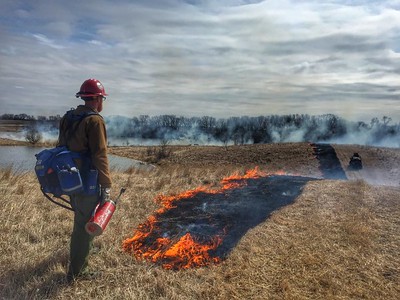Summary | Excerpt | Reading Guide | Reviews | Beyond the Book | Read-Alikes | Genres & Themes | Author Bio

A Novel
by Nathan HillThis article relates to Wellness
 In Nathan Hill's novel Wellness, protagonist Jack is from the Kansas prairie, where his father was an expert at managing prairie fires. Prairie fires may look terrifying and unwieldy, but in fact they are often purposeful and controlled, and play a critical role in maintaining healthy ecosystems. In much of North America, prairies were historically sustained through regular, intentional fires by Native people.
In Nathan Hill's novel Wellness, protagonist Jack is from the Kansas prairie, where his father was an expert at managing prairie fires. Prairie fires may look terrifying and unwieldy, but in fact they are often purposeful and controlled, and play a critical role in maintaining healthy ecosystems. In much of North America, prairies were historically sustained through regular, intentional fires by Native people.
There are a few different but related reasons that fire is so effective for maintaining prairie land. Crucially, fire stops the spread of trees and other woody vegetation by burning saplings before they mature enough to disperse seeds. If those saplings get too big, they steal sunlight and water from the prairie plants underneath—which is the stuff animals actually want to graze on—and that grassland can easily turn into forest. Because so much of the grassland plant biomass is underground, it remains safe from the fire. A rangeland ecologist puts it this way: "It's actually pretty simple: When there's fire, grass wins. Without fire, trees win."
Burning the prairie does more than just rid the land of the encroaching forest—it also triggers vigorous regrowth, which then attracts animals for grazing. The newly-grown grass that comes up after a fire is more nutritious than older grass, so wildlife flock to it.
Relatedly, prairie fires promote biodiversity. The American Prairie Foundation describes a healthy prairie as being like a patchwork quilt—some patches have been burned more recently than others; some patches are more heavily grazed than others. Each patch is an ideal habitat for some species at some point in their lifecycle, so the prairie as a whole allows for the habitation of many different species. The Spring Creek Prairie Audubon Center notes that this is particularly noticeable in birds—"Henslow's Sparrows, for example, require a thick thatch layer that accumulates in areas that haven't burned for several years. Killdeer, on the other hand, prefer recently burned areas." And most species have needs somewhere in between.
Finally, prescribed burns can prevent wildfires, or at least reduce the intensity of them. If there aren't planned fires, leaf litter can build up over time and provide plenty of fuel for a wildfire to fly through, making it much harder to control.
Native people, obviously the original dwellers on prairie land, once used fire for all these reasons and more, including driving and attracting game. Intentional burning has been an ingenious and necessary, if potentially dangerous, development in North America, but was outlawed by the United States government for over a century. In recent decades, it is increasingly being used again as government organizations have begun to recognize its value, though Indigenous people say that further change is necessary to bring back traditional burning practices and their ecological benefits.
Controlled burn at the Froland Waterfowl Production Area in Minnesota
Photo by Alex Galt/USFWS
Filed under Nature and the Environment
![]() This article relates to Wellness.
It first ran in the October 4, 2023
issue of BookBrowse Recommends.
This article relates to Wellness.
It first ran in the October 4, 2023
issue of BookBrowse Recommends.
Your guide toexceptional books
BookBrowse seeks out and recommends the best in contemporary fiction and nonfiction—books that not only engage and entertain but also deepen our understanding of ourselves and the world around us.